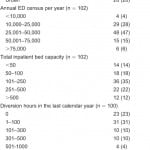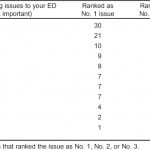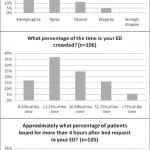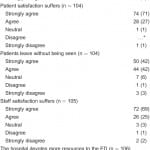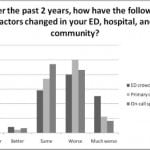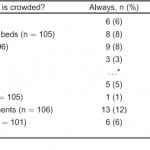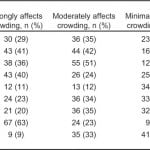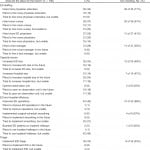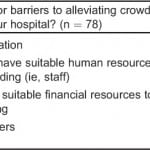| Author | Affiliation |
|---|---|
| Jesse M. Pines, MD, MBA, MSCE | George Washington University Medical Center, Departments of Emergency Medicine and Health Policy, Washington, DC |
| Joshua A. Isserman, MS | Sackler School of Medicine, Tel Aviv, Israel |
| John J. Kelly, DO | Albert Einstein Medical Center, Department of Emergency Medicine, Philadelphia, Pennsylvania |
ABSTRACT
Introduction:
The state of emergency department (ED) crowding in Pennsylvania has not previously been reported.
Methods:
We assessed perceptions of ED crowding by surveying medical directors/chairs from Pennsylvania EDs in the spring of 2008.
Results:
A total of 106 completed the questionnaire (68% response rate). A total of 83% (86/104) agreed that ED crowding was a problem; 26% (27/105) reported that at least half of admitted patients boarded for more than 4 hours. Ninety-eight percent (102/104) agreed that patient satisfaction suffers during crowding and 79% (84/106) stated that quality suffers. Sixty-five percent (68/105) reported that crowding had worsened during the past 2 years. Several hospital interventions were used to alleviate crowding: expediting discharges, 81% (86/106); prioritizing ED patients for inpatient beds, 79% (84/106); and ambulance diversion, 55% (57/105). Almost all respondents who had improved ED operations reported that it had reduced crowding.
Conclusion:
ED crowding is a common problem in Pennsylvania and is worsening in the majority of hospitals, despite the implementation of a variety of interventions.
INTRODUCTION
Emergency department (ED) crowding is a major public health problem in the United States.1National surveys report a very high prevalence of ED crowding—as high as 91% in 2001.2 Several causes for ED crowding have been proposed; however, the underlying problem is a fundamental mismatch between demand by patients for care and ED and hospital capacity.3–5 This supply-demand mismatch has also been shown to have several adverse effects on patients during times of ED crowding. These include long waiting times, poorer satisfaction and pain control, treatment in hallways, a reduced ability to deliver time-sensitive interventions, such as antibiotics in cases of pneumonia and percutaneous intervention in acute myocardial infarction, and poorer survival and complication rates.6–12
Several recent reports have proposed solutions to the crowding problem.13–15 In addition, many interventions to alleviate crowding have been deployed in individual hospitals and in state-level policy. For example, the Department of Health in New York has allowed hospitals to move admitted patients to inpatient hallways when the ED is at full capacity.16 However, there are few studies that have detailed the results of interventions. There is also little published information on which interventions have been implemented, which have been difficult to implement, and which have the highest impact on improving overall patient flow.
The measurement of ED crowding has been a challenge. Several measures, such as ED occupancy and other measures, have been proposed. Prolonged ED length of stay has been associated with ED crowding and is one of the measures used to measure ED crowding retrospectively.17 In 2013, the Centers for Medicare and Medicaid Services will provide incentive payments for specific measures of ED length of stay.18 However, there are no states that explicitly require hospitals to report patient flow indicators, nor have there been any statewide assessments of the feasibility of reporting systems. In the absence of any national and state-specific reporting requirement and before hospitals start reporting in 2013, there is little information outside of investigator-initiated research to assess the prevalence of crowding. There is currently noway for patients to assess expected or actual wait times when seeking emergency services, outside of EDs who report these times publicly to the local community.
We sought to assess perceptions of ED crowding at the level of ED administration across Pennsylvania by surveying ED medical directors with the goal of (1) determining perceptions on the prevalence of and trends in ED crowding and boarding across the state and (2) assessing the reported use of various interventions aimed at alleviating ED crowding.
METHODS
Study Design and Participants
We performed a cross-sectional survey of department chairs and medical directors in EDs in Pennsylvania focused on ED crowding. Hospitals were included if they were located in Pennsylvania and had a hospital-based ED that was open during the study period. Urgent care centers and veterans hospitals were excluded because crowding issues are different in those hospitals and they are not subject to the Emergency Medical Treatment and Labor Act rules. The initial list of hospitals and contact information was obtained from the Pennsylvania Chapter of the American College of Emergency Physicians (PaACEP).
Data Collection and Processing
Data were collected in the spring of 2008 by a series of email announcements, postage surveys, and follow-up telephone calls. The initial e-mail announcement with a hyperlink to the online survey was sent 4 times. After the initial e-mail announcements, in cases of nonresponse or nonfunctional email, PaACEP sent a paper survey by mail up to 3 times. Remaining nonresponders were contacted by telephone to direct participants to the online survey. A response was determined as being any of the data filled out in the online or paper surveys, or by telephone. Aside from aiding with the initial list of hospitals and with survey mailing, PaACEP was not directly involved in this study.
Data were collected by using an online survey package (http://www.surveymonkey.com; SurveyMonkey, Portland, Oregon). Questions with multiple possible choices were placed in random order to minimize bias. The survey software allowed respondents to skip specific questions and still submit the survey.
The survey was designed to ask specific questions about the level of crowding, boarding, and interventions that had been implemented to alleviate crowding. At the outset of the survey, ED crowding was defined as, “. . . the functional state of an ED where demand for services exceeds resource supply.” Hospitals were asked to identify the name of their hospital in the survey for tracking purposes and they were reassured that hospitalspecific information would not be reported. The purpose of this was to ensure more accurate data reporting and to increase the likelihood of reporting potentially sensitive information. We used the following language to introduce participants to the survey: “To protect your confidentiality and to encourage your most honest answers, please be assured that we will be deidentifying the data for the analysis. Hospital-specific information will NOT be reported to the state.” Accordingly, no hospital-specific information is published in this report. The survey instrument was developed and refined in 2 separate research conferences in the Departments of Emergency Medicine at the University of Pennsylvania and Albert Einstein Medical Center. The survey was then piloted locally among the emergency physician faculty at both centers to ensure that the survey was easy to understand. For some questions, write-in answers were allowed.
Additional data on the EDs were obtained to assess for nonresponse bias, including Level I trauma designation (http://www.amtrauma.org), PA region (http://www.phc4.org)— including Southeastern PA, Central PA, and Western PA—and the presence of an emergency medicine residency training program (http://www.saem.org/saemdnn/). The institutional review boards at the University of Pennsylvania and Albert Einstein Medical Center, both of which are located in Philadelphia, Pennsylvania, approved the study.
Data Analysis
The primary data were tabulated from answers to survey questions. We compared responders to nonresponders by using Fisher exact tests. A P value of 0.05 or less was considered significantly different. Stata 10 (Stata Corporation, College Station, Texas) was used for the data analysis.
RESULTS
Assessment of Response Rate, Nonresponse Bias, and Characteristics of Participant Hospitals
Among the 156 EDs meeting our inclusion criteria in Pennsylvania, 106 separate EDs responded (response rate = 68%). Of the 106 hospitals, 100 (94%) identified the name of their hospital, permitting an assessment of nonresponse bias. A total of 11 (11%) respondents had emergency medicine residency programs; 44 (44%) were in Southeastern PA; 32 (32%), in Western PA; and 24 (24%), in Central PA; 20 (20%) were trauma centers. Respondent hospitals were more likely to have EM residencies (11% versus 0%, P=0.01) and be trauma centers (20% versus 8%, P = 0.07). There was no statistical difference in Pennsylvania region across respondent hospitals (P = 0.65). Of the 106 hospitals, 101 answered questions on hospital demographics. (Table 1) Most hospital respondents were nonurban hospitals with between 100 to 500 beds, with a census of 10,000 to 50,000 patients.
Table 1. Characteristics of hospital emergency departments (ED) in Pennsylvania that participated in the survey (n = 106).
The Importance of ED Crowding Compared to Other Issues Facing EDs
Emergency department directors across Pennsylvania rated ED crowding as the most important issue affecting their ED, with 30 directors ranking crowding as the number 1 issue; 22, as the number 2 issue; and 13, as the number 3 issue. Other important issues included quality of ED care, with 21 ranking it as the number 1 issue; reimbursement for ED care, with 10 ranking it as the number 1 issue; and physician and nurse retention, which were ranked the number 1 issue by 9 and 8 directors, respectively (Table 2).
Table 2. Major issues affecting Pennsylvania emergency departments (ED) (n = 106).
Prevalence of ED Crowding and Boarding
In all, 84% (n= 87) of ED directors agreed or strongly agreed that crowding was a problem in their hospital. The highest percentage of EDs (37% [n= 39]) reported that they were crowded 11% to 25% of the time, while 24% (n= 25) reported that their EDs were crowded 26% to 50% of the time. The highest percentage of EDs (33% [n= 35]) reported that boarding (defined as transfer to an inpatient bed > 4 hours after request) occurred for 1% to 10% of admitted patients (Figure 1).
Figure 1. The prevalence of emergency department (ED) crowding and boarding in Pennsylvania hospitals.
Consequences of ED Crowding
The most frequently cited adverse consequence of crowding was patient and staff dissatisfaction, with 98% and 95% of ED directors agreeing or strongly agreeing, respectively, that this occurred in their hospital when the ED was crowded. Other adverse consequences included a high proportion of EDs reporting that patients leave without being seen (84%) and that quality of care suffers (79%) during crowded times. A high percentage (73%) agreed or strongly agreed that when crowding occurred, admitted patients were boarded for long periods. However, only 32% of ED directors agreed or strongly agreed that their hospital devoted more resources to the ED during times of crowding and 30%reported going on diversion (Table 3).
Table 3. Consequences of emergency department (ED) crowding in Pennsylvania hospitals.
Trends in ED Crowding, On-Call Specialists, and Primary Care Access
Within the past 2 years, 65% of ED directors reported that crowding had become worse or much worse in their hospital, while 61% reported that primary care access was worse or much worse in their community. In addition, 53% reported that on-call specialist availability had worsened (Figure 2).
Figure 2. Changes in emergency department (ED) crowding, primary care access, and on-call specialist availability in Pennsylvania (n = 105).
Strategies Used by Hospitals When the ED Becomes Crowded
A total of 81% of EDs reported that their hospitals sometimes or always expedite inpatient discharges, while 61% reported that their hospitals sometimes rapidly transfer ED patients to inpatient beds. Several strategies were never used during crowded times. For example, 82% of hospitals report never triaging patients to other acute settings, 81% never cancel elective surgeries, 77% never move admitted patients to inpatient hallways, and 76% never use a hospital-wide disaster plan (Table 4).
Table 4.Specific strategies used when emergency departments (ED) become crowded in Pennsylvania hospitals.
Factors Affecting Crowding
Several factors were reported to affect crowding, the most frequent being delayed bed placement for admitted patients (63%). Other important factors that strongly affected crowding were an increase in ED volume (41%), insufficient ED space (40%), and an increase in patient acuity (36%) (Table 5).
Table 5. Factors affecting emergency department (ED) crowding in Pennsylvania hospitals.
Recent, Future, and Failed Interventions to Alleviate Crowding and Which Have Been Successful at Reducing Crowding
All hospitals reported interventions that had been implemented in the last 2 years to help alleviate crowding in their hospitals. The most frequent interventions were improving ED operations (40%), hiring more ED nurses (37%) and physician extenders (33%), and implementing the emergency severity index triage (33%). Almost all (98%) who tried to improve ED operations reported that it improved the crowding situation. Of those EDs that hired physician extenders, 71% found this to be useful to alleviate crowding. Several EDs tried to implement interventions, but were not successful. The most frequent failed interventions were attempts at boarding admitted ED patients in inpatient hallways (40%) and at implementing surgical schedule smoothing (21%). Interestingly, while 4 of 6 (67%) hospitals that implemented surgical smoothing found this to be helpful in alleviating crowding, only 1 of 5 (20%) hospitals that used inpatient hallways to board ED patients reported that it reduced crowding. (Table 6).
Table 6. Interventions to alleviate emergency department (ED) crowding in the past 2 years (2006–2007) in Pennsylvania hospitals.
Major Barriers for Alleviating Crowding
The most frequent barrier to improving ED crowding was hospital administration (52%), followed by insufficient ED human resources (48%), and ED financial resources (45%) (Table 7).
Table 7. Major barriers to alleviating emergency department (ED) crowding in Pennsylvania hospitals.
DISCUSSION
Consistent with national reports, we found perceptions of a very high prevalence of ED crowding in Pennsylvania.1,2 This is also consistent with previous state-level reports demonstrating a high level of ED crowding in California, Florida, Texas, and New York.19,20 In Pennsylvania, while crowding is the largest issue facing EDs, it does not appear to occur all the time in most hospitals. This reflects the cyclical nature of ED demand, where crowding may be present at certain times of the day, week, month, or year.21 The supply-demand mismatch is present in most EDs some of the time, but the proportion of time for which there are insufficient resources to handle ED patients is highly variable, depending upon the hospital. Few EDs report a supply-demand mismatch all the time, but most report it part of the time. We found a similar pattern in the rates of ED boarding, where only a small proportion of EDs report that more than 50% of EDs admitted patients board for more than 4 hours and most report that somewhere between 1% to 10% board for more than 4 hours.
During episodes of crowding, there was clear consensus that crowding lowers patient and staff satisfaction. The effect of ED crowding on patient satisfaction has been reported recently, with ED crowding, hallway bed placement, and long boarding times resulting in lower patient satisfaction.6Quality of care was also reported to be a major issue, which is confirmed by reports that have shown an association between ED crowding and process measures, such as time to antibiotics in cases of pneumonia and the timing and provision of pain control.7,8,22,23 In addition, a recent report found that crowding lengthens the overall time in the ED, even for high-acuity patients.17 There was also general agreement that patients leave without being seen, which is a known consequence of long waits.24,25 However, only a minority of hospitals reported using ambulance diversion during times of crowding, which may reflect local or regional policies.
Most medical directors reported that crowding had worsened across the state during the pat 2 years. While the Emergency Medicine Transfer and Active Labor Act requires that all patients presenting to the ED have a screening examination, there have been few state or national policies that require hospitals to provide timely emergency care. In addition, because more than half of ED directors report that primary care access is worse, ED volume may be increasing to make up for the shortfall of urgent primary care services in Pennsylvania.26
Most hospitals report a change in operations during crowded times. These changes most frequently include expediting inpatient discharges, prioritizing ED patients for inpatient beds, and rapidly transferring ED patients to inpatient beds. Because boarding is a central cause for crowding, it would make sense that hospitals would attempt to rapidly move admitted patients out of the ED in response to crowding.27 Several strategies were used by a minority of hospitals, including cancelling elective surgeries, stopping intrahospital transfers, and moving ED patients to inpatient hallways. Because non-ED admissions generate higher revenues, it would make sense that from a purely economic perspective, hospitals would be hesitant to cancel transfers for profitable patients compared to the less profitable ED patients waiting for inpatient beds.28
Emergency department directors named delays in inpatient bed placement as having the strongest effect on crowding. Boarding as a central cause for crowding has been confirmed in several reports.22,29,30, Increased volume, increased acuity, and insufficient ED space were also named as strong contributors to crowding across Pennsylvania. These factors are also known causes for crowding and capacity issues. Efficiency issues were reported to have a moderate effect on crowding, such as delays in radiology and delays in consultation. A similar finding was noted in a report that detailed systematic delays in time to antibiotic administration for patients with pneumonia where one component, a delay in radiology, was a significant factor in delayed antibiotic administration.31
When asked which interventions had been performed to alleviate crowding during the previous 2 years, only 40% of EDs reported there had been an active intervention. The most common intervention was improving ED efficiency, which was also reported by nearly all medical directors to help alleviate crowding. About one third to one fourth of EDs reported that they had hired more staff (physicians, physician extenders, and nurses), increased ED space, or hired a bed manager. Of those interventions, hiring physician extenders seemed to have the greatest effect on reducing crowding, with more than 70% reporting an improvement. Hiring physician extenders may improve crowding by expediting care for low severity cases. Implementation of 2 interventions that involve support outside the ED was reported to be largely unsuccessful. More than 40% of EDs reported the inability to use inpatient hallways for admitted patients. In addition, 20% reported attempting to implement surgical schedule smoothing but had met with failure. Surgical schedule smoothing is the process of balancing surgery loads throughout the week (ie, an equal number of surgeries every day), as opposed to what is commonly done in hospitals, which is to schedule elective surgeries during weekdays.32,33 Respondents did not detail why surgical smoothing and the use of inpatient floors, successful solutions to ED crowding in other states, had not been implemented in their EDs in Pennsylvania. However, of the few hospitals that had been able to implement smoothing, 4 of 6 reported that it had reduced crowding. Given these preliminary results, surgical schedule smoothing appears to be a promising intervention to reduce ED crowding. By contrast, only 1 of 5 hospitals that use inpatient floors for admitted patients reported that it has successfully reduced crowding. This may indicate that the use of inpatient floors for admitted patients as a strategy to reduce crowding may have less impact than expected.34
However, these data do suggest that certain strategies to reduce crowding may have greater impact than others. Given the fact that, by itself, improving ED operations seems to universally improve ED crowding, it is unclear whether hospitals should look to their ED to improve throughput, or look more to non-ED interventions, such as surgical smoothing, which seem similarly useful, but much more difficult to implement. Comparative studies aimed at determining which interventions are most effective at reducing crowding and the logistics of implementing them (ie, the buy-in needed to achieve an intervention) will be helpful in guiding hospitals to improve ED flow.
Several barriers to improving ED crowding were listed. Approximately one half of ED directors reported that hospital administration was a major barrier. The difficulty associated with effecting change in hospitals, as well as the varied priorities of stakeholders, may contribute to this negative perception of hospital administrators. Similarly, approximately half of ED directors reported that they did not have sufficient human or financial resources to improve crowding. A reluctance of hospital administration to provide support or resources to ED crowding may be due to the way in which crowding is prioritized by hospitals and perceptions that crowding is more of an ED problem than a hospital-wide problem.
LIMITATIONS
There are several limitations to this study. The greatest limitation of this study was that we did not verify any of the answers, so it is possible that some of the survey responses may not be accurate. For example, it is unknown whether the medical directors used real data for many of the quantitative questions or whether they used estimates. In addition, these data may represent a biased sampled because we did not sample 100% of Pennsylvania EDs and because those EDs responding were more likely to have ED residency programs. Because residency programs tend to be in more populated areas, the data may overestimate the level of crowding across Pennsylvania EDs. It may be more difficult to generalize these data to community hospitals that did not answer the survey. It is also possible that respondent hospitals differed on factors that we did not report, such as ED volume. We attempted to reduce nonresponse bias by trying to maximize our response rate through using several survey requests and multiple modalities (e-mail, paper mail, and phone calls). Another limitation is that these data were obtained from medical directors, who may have their own crowding bias, affecting how they responded to survey questions. Even though we explicitly communicated that we would not publicly release the individual results from their hospitals, the fact that they identified their hospital may have influenced how they estimated the level of crowding and reported data. However, medical directors likely are in the best position to provide accurate data on this issue. We were also limited by our survey instrument, which was developed and piloted locally, but was not rigorously validated. Finally, for this study, we defined boarding as occurring 4 hours or more after a bed request. Since a recent report has defined boarding as a shorter time interval from the bed request (2 hours), our definition may have underestimated the level of boarding across the state.35
CONCLUSION
According to ED medical directors across Pennsylvania, crowding is currently the number one issue facing their EDs in the state. Most directors report that crowding and boarding occur some of the time, while few report it occurs all the time. There appears to be consensus that crowding has a negative impact on patient and staff satisfaction, and in most EDs, quality of care. However, a minority report that greater resources are devoted to the ED during episodes of crowding. Several factors affecting ED crowding were identified in this report, but boarding of ED-admitted patients appears to be the most common. Many interventions have been implemented and the most successful ones include improving ED operations, hiring physician extenders, and smoothing of surgical schedule. Improving ED operations may include ED-specific interventions such as bedside registration or improvements in the way the ED itself functions. Interventions that involve collaboration outside the ED, such as moving patients to inpatient hallways and surgical schedule smoothing, have been difficult to implement in many hospitals. Hospital administration is reported to be a barrier in approximately half of hospitals, as is having suitable financial and human resources to improve crowding.
Footnotes
Supervising Section Editor: Jeremy J. Hess, MD
Submission history: Submitted January 1, 2011; Revision received April 10, 2011; Accepted May 23, 2011
Full text available through open access at http://escholarship.org/uc/uciem_westjem
DOI: 10.5811/westjem.2011.5.6700
Address for Correspondence: Jesse M. Pines, MD, MBA, MSCE, Center for Health Care Quality, 2121 K St, Ste 200, Washington, DC 20037
E-mail: jesse.pines@gmail.com
Conflicts of Interest: By the WestJEM article submission agreement, all authors are required to disclose all affiliations, funding sources, and financial or management relationships that could be perceived as potential sources of bias. The authors disclosed none.
REFERENCES
1. Institute Of Medicine. IOM report: the future of emergency care in the United States health system.Acad Emerg Med. 2006;13:1081–1085. [PubMed]
2. Derlet R, Richards J, Kravitz R. Frequent overcrowding in U.S. emergency departments. Acad Emerg Med. 2001;8:151–155. [PubMed]
3. Eitel DR, Rudkin SE, Malvehy MA. et al. Improving service quality by understanding emergency department flow: a white paper and position statement prepared for the American Academy of Emergency Medicine. J Emerg Med. 2010;38:70–79. [PubMed]
4. Burt CW, McCaig LF. Trends in hospital emergency department utilization: United States, 1992–99.Vital Health Stat 13. 2001. pp. 1–34.
5. American College of Emergency Physicians 1998–1999 Safety Net Task Force. Defending America’s Safety Net. Dallas, TX: American College of Emergency Physicians; 1999.
6. Pines JM, Iyer S, Disbot M. et al. The effect of emergency department crowding on patient satisfaction for admitted patients. Acad Emerg Med. 2008;9:825–831. [PubMed]
7. Pines JM, Hollander JE. Emergency department crowding is associated with poor care for patients with severe pain. Ann Emerg Med. 2008;51:1–5. [PubMed]
8. Pines JM, Localio AR, Hollander JE. et al. The impact of emergency department crowding measures on time to antibiotics for patients with community-acquired pneumonia. Ann Emerg Med.2007;50:510–516. [PubMed]
9. Chalfin DB, Trzeciak S, Likourezos A. et al. Impact of delayed transfer of critically ill patients from the emergency department to the intensive care unit. Crit Care Med. 2007;35:1477–1483. [PubMed]
10. Carr BG, Kaye AJ, Wiebe DJ. et al. Emergency department length of stay: a major risk factor for pneumonia in intubated blunt trauma patients. J Trauma. 2007;63:9–12. [PubMed]
11. Pines JM, Pollack CV, Jr, Diercks DB. et al. The association between emergency department crowding and adverse cardiovascular outcomes in patients with chest pain. Acad Emerg Med.2009;16:617–625. [PubMed]
12. Kulstad EB, Kelley KM. Overcrowding is associated with delays in percutaneous coronary intervention for acute myocardial infarction. Int J Emerg Med. 2009;2:149–154. [PMC free article][PubMed]
13. Bernstein SL, Asplin BR. Emergency department crowding: old problem, new solutions. Emerg Med Clin North Am. 2006;24:821–837. [PubMed]
14. Olshaker JS, Rathlev NK. Emergency Department overcrowding and ambulance diversion: the impact and potential solutions of extended boarding of admitted patients in the Emergency Department. J Emerg Med. 2006;30:351–356. [PubMed]
15. American College of Emergency Physicians. Emergency department crowding: high-impact solutions. American College of Emergency Physicians Web site. Available at:www.acep.org/workarea/showcontent.aspx?id=37960. Accessed December 22, 2008.
16. Garson C, Hollander JE, Rhodes KV. et al. Emergency department patient preferences for boarding locations when hospitals are at full capacity. Ann Emerg Med. 2008;51:9–12. [PubMed]
17. McCarthy ML, Zeger SL, Ding R. et al. Crowding delays treatment and lengthens emergency department length of stay, even among high-acuity patients. Ann Emerg Med. 2009;54:492–503.[PubMed]
18. US Department of Health and Human Services. Proposed changes to the hospital outpatient prospective payment system and CY 2012 payment rates. Centers for Medicare and Medicaid Services Web site. Available at: http://www.cms.gov/HospitalOutpatientPPS/HORD/itemdetail.asp?itemID=CMS1240960&. Accessed April 8, 2011.
19. Richards JR, Navarro ML, Derlet RW. Survey of directors of emergency departments in California on overcrowding. West J Med. 2000;172:385–388. [PMC free article] [PubMed]
20. Derlet RW, Richards JR. Emergency department overcrowding in Florida, New York, and Texas.South Med J. 2002;95:846–849. [PubMed]
21. Asplin BR, Flottemesch TJ, Gordon BD. Developing models for patient flow and daily surge capacity research. Acad Emerg Med. 2006;13:1109–1113. [PubMed]
22. Fee C, Weber EJ, Maak CA. et al. Effect of emergency department crowding on time to antibiotics in patients admitted with community-acquired pneumonia. Ann Emerg Med. 2007;50:501–509.[PubMed]
23. Hwang U, Richardson L, Livote E. et al. Emergency department crowding and decreased quality of pain care. Acad Emerg Med. 2008;15:1248–1255. [PMC free article] [PubMed]
24. Monzon J, Friedman SM, Clarke C. et al. Patients who leave the emergency department without being seen by a physician: a control-matched study. CJEM. 2005;7:107–113. [PubMed]
25. Kulstad EB, Hart KM, Waghchoure S. Occupancy rates and emergency department work index scores correlate with leaving without being seen. West J Emerg Med. 2010;11:324–328.[PMC free article] [PubMed]
26. Rust G, Ye J, Baltrus P. et al. Practical barriers to timely primary care access: impact on adult use of emergency department services. Arch Intern Med. 2008;168:1705–1710. [PubMed]
27. Schull MJ, Lazier K, Vermeulen M. et al. Emergency department contributors to ambulance diversion: a quantitative analysis. Ann Emerg Med. 2003;41:467–476. [PubMed]
28. McHugh M, Regenstein M, Siegel B. The profitability of Medicare admissions based on source of admission. Acad Emerg Med. 2008;15:900–907. [PubMed]
29. Bond K, Ospina MB, Blitz S. et al. Frequency, determinants and impact of overcrowding in emergency departments in Canada: a national survey. Healthc Q. 2007;10:32–40. [PubMed]
30. Yancer DA, Foshee D, Cole H. et al. Managing capacity to reduce emergency department overcrowding and ambulance diversions. Jt Comm J Qual Patient Saf. 2006;32:239–245. [PubMed]
31. Pines JM, Morton MJ, Datner EM. et al. Systematic delays in antibiotic administration in the emergency department for adult patients admitted with pneumonia. Acad Emerg Med.2006;13:939–945. [PubMed]
32. McManus ML, Long MC, Cooper A. et al. Variability in surgical caseload and access to intensive care services. Anesthesiology. 2003;98:1491–1496. [PubMed]
33. Litvak E, Buerhaus PI, Davidoff F. et al. Managing unnecessary variability in patient demand to reduce nursing stress and improve patient safety. Jt Comm J Qual Patient Saf. 2005;31:330–338.[PubMed]
34. Viccellio A, Santora C, Singer AJ. et al. The association between transfer of emergency department boarders to inpatient hallways and mortality: a 4-year experience. Ann Emerg Med.2009;54:487–491. [PubMed]
35. Welch S, Augustine J, Camargo CA., Jr Emergency department performance measures and benchmarking summit. Acad Emerg Med. 2006;13:1074–1080. et al. [PubMed]



